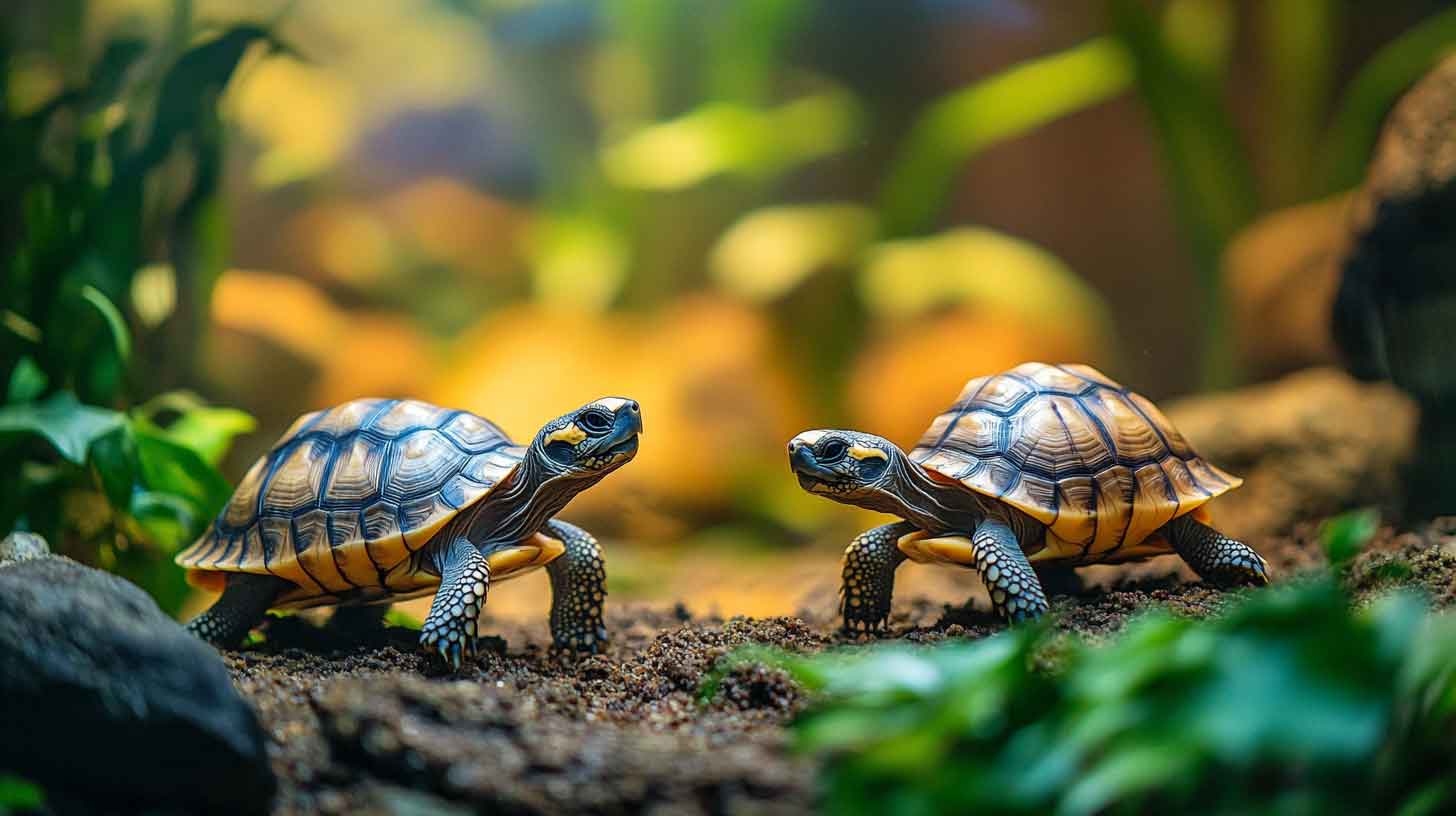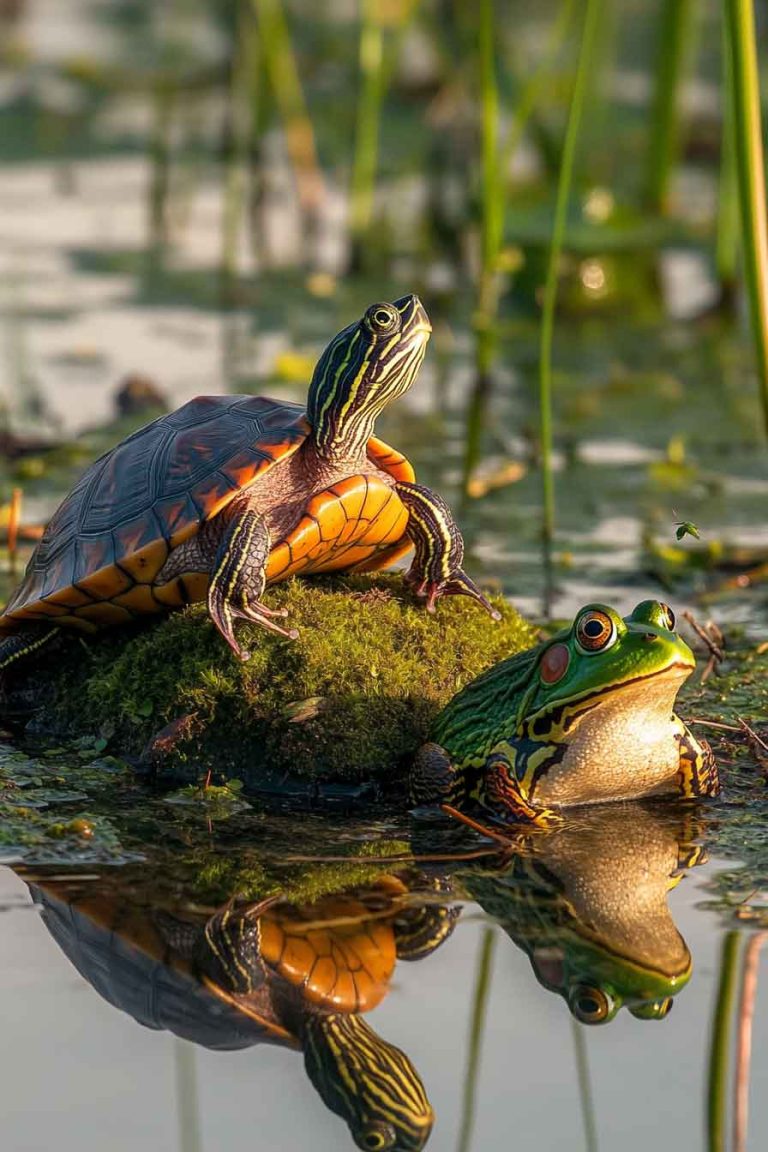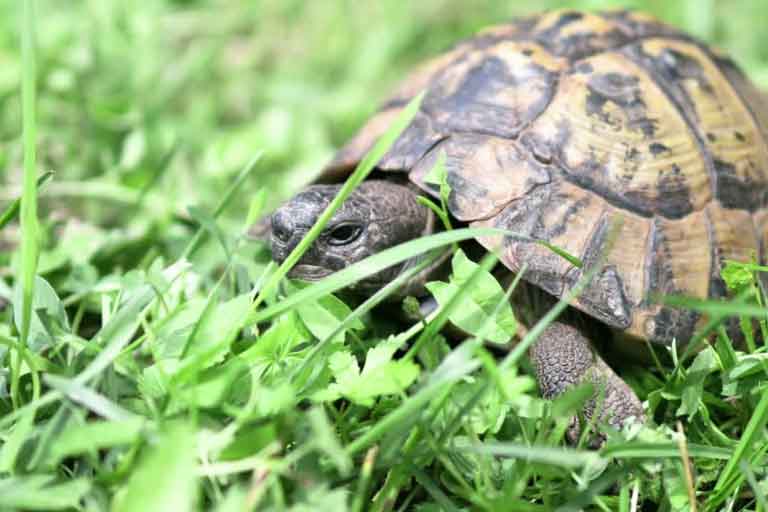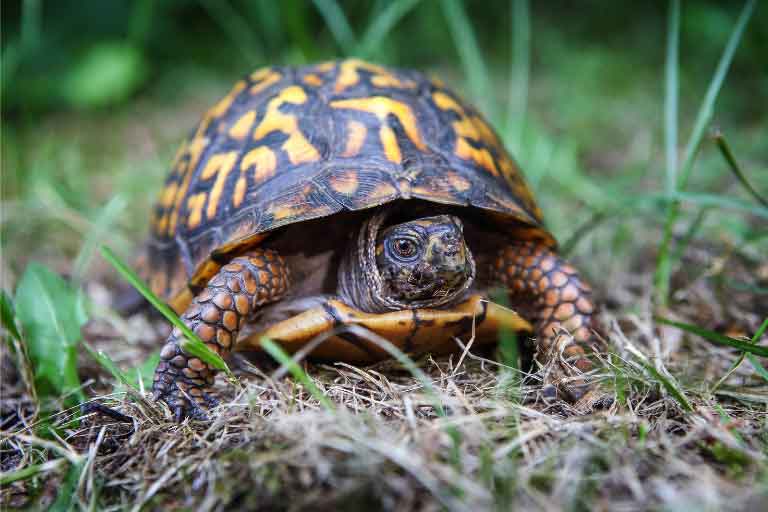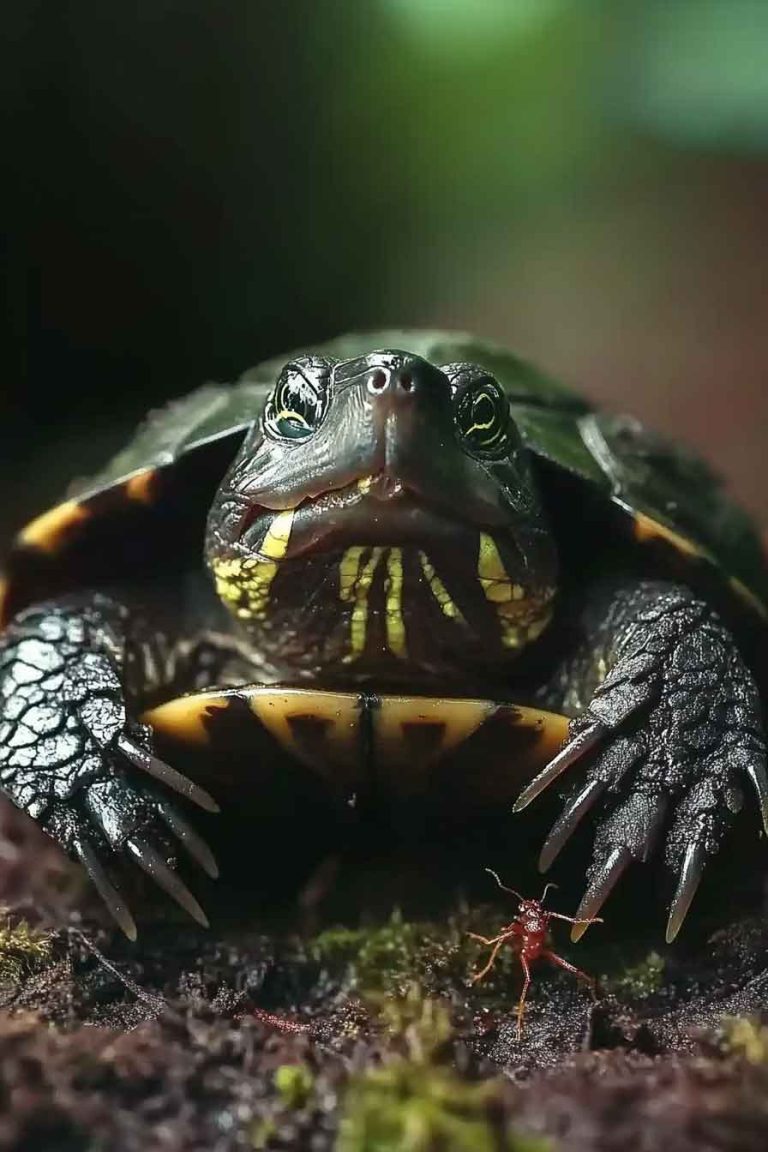Can Turtles and Frogs Live Together? | Dangers, Compatibility & Expert Advice
I remember the first time I considered putting a frog in with my turtle. It seemed harmless. They both liked water. They were both small. They both looked peaceful—like they wouldn’t hurt a fly. But what I didn’t know at the time was that combining them in the same tank could lead to injury, stress,…
I remember the first time I considered putting a frog in with my turtle. It seemed harmless. They both liked water. They were both small. They both looked peaceful—like they wouldn’t hurt a fly. But what I didn’t know at the time was that combining them in the same tank could lead to injury, stress, or even death.
That might sound dramatic—but it’s the truth.
So if you’re thinking of housing your turtle and frog together, or you saw a cool mixed-terrarium setup online and want to recreate it, pause and read this first. Because while it might look good on Pinterest, the reality in your tank could be very different.
Can Turtles and Frogs Live Together?
Technically, yes—for a short time. But should they? Absolutely not.
Turtles and frogs are two completely different species with very different environmental needs, feeding habits, and social behaviors. Just because they both enjoy water doesn’t mean they can share a living space safely.
I’ve been keeping turtles for years, and I’ve talked to enough herpetologists and amphibian keepers to confidently say: turtles and frogs are not tankmates. Even if things seem peaceful at first, the long-term risks outweigh any benefit.
Let me break it down.
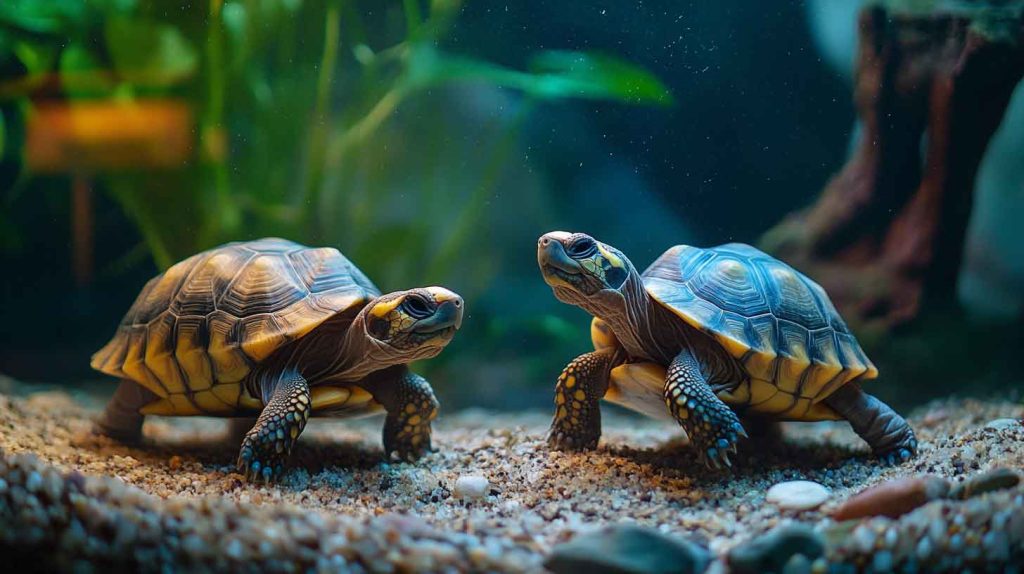
Why People Try to House Turtles and Frogs Together
1. “They both like water.”
That’s the most common reason people assume they’ll get along. But there’s a big difference between liking water and needing the same type of water.
- Most aquatic turtles (like red-eared sliders, cooters, and painted turtles) need deep water and strong filtration.
- Frogs (like tree frogs, Pacman frogs, or bullfrogs) need shallow water or damp land with high humidity—and sometimes vertical space for climbing.
Trying to find a single setup that works for both almost always means one of the two is living in subpar conditions.
2. “They look peaceful.”
Turtles are deceptive that way. They move slow, bask a lot, and generally seem chill. But they are opportunistic omnivores. If something small moves near their mouth—even if it’s not food—they may bite it just to “test” it.
Frogs, on the other hand, have soft, permeable skin that bruises easily and absorbs harmful bacteria. One curious bite from a turtle could be enough to seriously wound or kill a frog—even if the turtle doesn’t mean to be aggressive.
3. “They got along for a while.”
This one is tricky. I’ve heard from people who say their turtle and frog lived together for months without incident. But then one day, without warning, the frog disappeared. Or was found floating with a missing limb. Or died mysteriously.
The truth is, turtles don’t show aggression constantly. But when hunger, boredom, or territorial behavior kicks in, things can go downhill quickly. And it often happens when you’re not watching.
The Real Risks of Housing Turtles and Frogs Together
Even if your turtle and frog seem to coexist peacefully at first, the risks are very real—and often underestimated. Let’s walk through the biggest ones I’ve encountered and researched.
1. Turtles Might Eat the Frog
This isn’t a maybe. It’s a high-probability scenario.
Turtles are instinct-driven omnivores. If a frog moves suddenly, swims nearby, or looks bite-sized, a turtle will likely snap at it—even out of curiosity. I’ve seen it firsthand. My red-eared slider once lunged at a small fish I thought was too fast to catch. That fish disappeared within minutes.
Now imagine a frog—slower, softer, and more exposed.
Even if the turtle doesn’t swallow it whole, one bite can leave the frog with broken bones, torn skin, or deadly stress. Frogs simply aren’t built to survive those kinds of injuries.
2. Environmental Needs Are Incompatible
This is a big one.
Turtles:
- Need deep, clean water with constant filtration
- Thrive at water temps around 75–80°F
- Require a UVB basking area to regulate calcium and shell growth
- Create a ton of biological waste (they’re messy)
Frogs:
- Prefer shallow water or moist land
- Some species require high humidity and dense plant cover
- Often avoid strong water currents or deep areas
- Are sensitive to water pollutants
Trying to build one habitat that keeps both animals healthy often leads to a compromise that fails both.
When I tried to experiment with a partial land-water setup once, my turtle used the land portion as a toilet and the water section for feeding—and the entire tank got nasty, fast. I can only imagine what that would do to a delicate amphibian.
3. Disease Transmission
Turtles can carry Salmonella, and while they don’t typically get sick from it, frogs with their permeable skin and sensitive immune systems can become extremely vulnerable.
Other issues:
- Water shared by both can host fungal and bacterial infections
- Stress in one animal can lead to suppressed immunity, increasing risk of cross-contamination
- Turtles bite during feeding, potentially opening wounds that invite infection
Once you introduce open wounds and contaminated water, you’re walking a thin line—and frogs don’t have the same healing abilities that reptiles do.
4. Feeding Time = Danger Zone
Turtles are aggressive eaters. Frogs are slow, deliberate feeders.
If you try to feed them in the same tank:
- Your turtle might gobble up all the food before the frog even notices it
- Worse, the turtle might go after the frog, mistaking it for a snack
- Leftover food creates ammonia spikes and bacteria that affect the frog’s skin and lungs
Feeding them separately becomes a full-time job. And let’s be real—you’re going to miss a feeding or two eventually. That’s all it takes for something to go wrong.
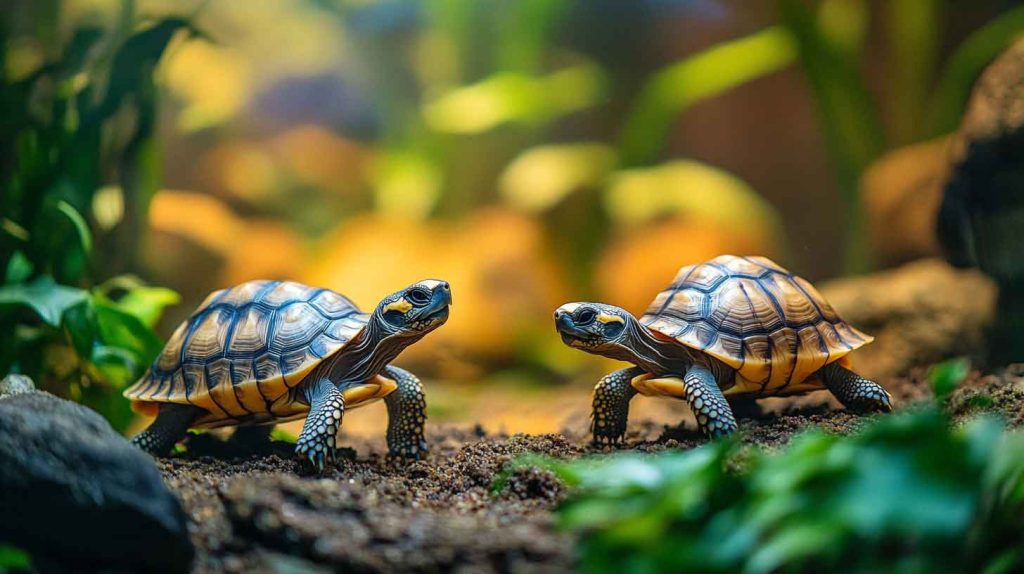
Safe Alternatives to Keeping Turtles and Frogs Together
If you’re still set on having both turtles and frogs in your care, I totally get it—they’re fascinating creatures. But instead of housing them in the same tank, here are better (and safer) ways to enjoy both without the risks.
1. Use Separate Enclosures
This is by far the safest and most practical option.
- Create a dedicated aquatic setup for your turtle, complete with UVB lighting, proper basking space, and strong filtration.
- For your frog, set up a species-appropriate terrarium—whether that’s a tropical frog habitat with high humidity or a semi-aquatic tank with more land than water.
You’ll have healthier pets, easier maintenance, and far less stress on both you and the animals.
2. Split-Tank Barrier Systems (For Advanced Keepers)
Some experienced keepers use a divided paludarium—a setup with an acrylic or mesh wall separating the turtle and frog spaces completely.
But this requires:
- Two independent heating and filtration systems
- Absolute prevention of cross-contamination (especially water)
- Separate feeding and cleaning routines
In other words, this setup is complex and not ideal for casual turtle or frog owners. If you’re not 100% confident in maintaining two micro-habitats in one tank, skip it.
3. Visual Cohabitation Without Contact
You can place their tanks side-by-side if you want the visual effect of a “shared space” without physical danger.
This satisfies the aesthetic you might be aiming for, but without the constant risks. I’ve done this myself with my turtle and a White’s tree frog—they lived in completely different tanks, but visually, it looked like one large natural display.
FAQs
1. Is there any species combo where turtles and frogs can live together?
Not reliably. Some people have kept large bullfrogs with small turtles temporarily, but even then, the risk of predation or environmental conflict is high. It’s not worth it for long-term care.
2. Can baby turtles and frogs grow up together safely?
Nope. Even if they start off the same size, turtles grow faster, and their appetite increases with age. One day, your turtle will see your frog as food—or at least a chew toy.
3. What’s the most dangerous time for cohabitation?
Feeding time. That’s when turtles are most active, most aggressive, and least discerning. Many injuries happen when food is introduced and animals are in high-stimulus mode.
Final Thoughts
I know the idea of a mixed-species tank is tempting. Frogs and turtles seem like they should get along. But in reality, they’re two very different animals with very different needs—and putting them together almost always ends in stress, injury, or worse.
If you care about their well-being—and I know you do—the best thing you can do is give each species its own space, its own environment, and its own care.
Your frog will thank you. Your turtle will thrive. And you’ll be a more informed and responsible keeper because of it.

